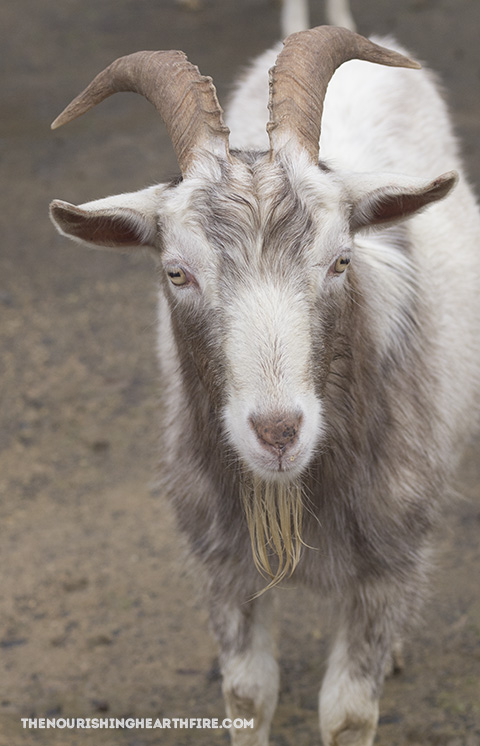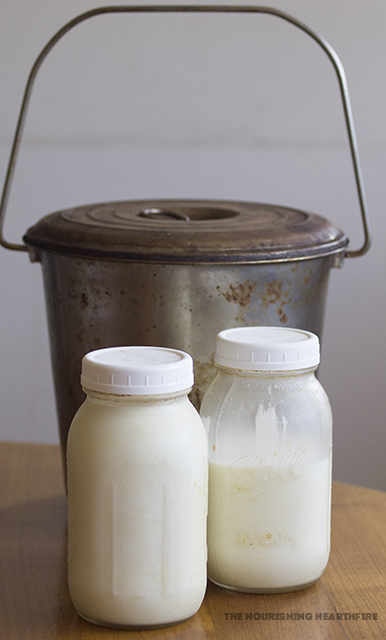Goats – The Perfect Dairy Animal to Start With, Wherever You Are

All photos courtesy Kate Downham of The Nourishing Hearthfire.
Many aspiring homesteaders dream of a dairy cow grazing contentedly on lush pasture, giving generous amounts of nourishing milk, and all the cream, butter, and cheese that can be made from it. To get to this point is a lot more complicated than dreaming, and one important step towards this goal can be to learn with goats.
Hand-milking involves developing strength in the hands, and the ability to make repetitive motions. It’s a lot easier to learn this with a goat that has a quart or two in her udder that easily flows out, than it is with a cow with two gallons, who might sometimes hold milk back. Goats can give confidence in dealing with dairy animals and knowing what to expect from milk flow, and what the udder feels like when it has milk in it, and when it is empty.
For making the most of seasonal abundance on the homestead, it’s important to know how to work with large amounts of milk at once. Culturing milk and making cheese are important skills that can be learned anywhere, and having a regular supply of goats milk in the kitchen can be the motivation to perfect these skills to the point where you know how to store the abundance for winter as hard cheese.

Other homesteaders might choose goats as their animal of choice, but may want to start later on, once they have the right land, the right plants growing, everything set up perfectly. Even once the infrastructure is in place, there is still a big learning curve in learning about goat behavior, preventing and treating goat health problems, milking, and turning that milk into cheese. In the meantime, food needs to come from somewhere, and fertility for the garden often needs to come from somewhere as well.
By keeping goats in a smaller fenced area, close to the house, we can interact and learn from goats, learn important skills, provide food for ourselves, and manure for the garden. Even in a suburban rental house, it’s possible to keep dairy goats, learning important skills along the way.
Establishing a homestead from scratch can take time, yet even if you need to feed your goats on brought-in hay, they will provide not just milk for your family, but manure for the homestead as well. Goat dairying is slow and steady work that helps to balance out all the frantic planting, weeding, mulching, clearing, fixing things, and building infrastructure in the early days of establishing a homestead. The instant harvest of goats milk can help to balance out the waiting game of planting fruit trees, building the soil up, and other slower ways towards abundance.
Manure from the goats will bring the fertility to the garden, orchard, pastures, and trees. Goats milk will nourish you and give you the energy to do more on the land. The joy that comes from keeping dairy goats and making beautiful cheeses will inspire you towards better homesteading.

The Needs of Goats
To work out whether you can get started with goats now, it’s important to learn a bit about what they need, and whether you can provide that.
Food
Goats can range free and choose their own food, or you can bring hay and tree branches to them. They have delicate digestive systems that don’t like too much of a new food at once, so it’s important to find a staple source of food for them, such as good-quality hay, or prunings from their favourite trees.
Water
It’s easy to provide this in buckets for them, and they don’t need nearly as much as cows.
Shelter
One large dog kennel per goat will be fine, or a simple three-sided shelter will work in most climates. If you get a lot of rain and snow, they will appreciate more indoor space, but in milder climates you can get away with roughly nine square feet of indoor sleeping area per goat. In areas with hot summers, you will also want to allow for shady areas for the goats to escape the sun such as under trees or shadecloth.
Observation
One of the keys to successfully keeping goats naturally is to be a good observer, and to pick up on any health issues early on, before they can get worse. Spending time with dairy goats is enjoyable, and observation is a skill that can develop naturally as you go.
Milking
Most goats will thrive on once per day milking. In the warm months that follow kidding season it’s possible to milk twice per day instead, to get twice as much milk, but most of the time this isn’t necessary. Goats generally give more milk if they’re milked at roughly the same time every day, but their milking times do not need to be set in stone, and they won’t mind too much if you’re a few hours late every now and then.
For much more detail and inspiration for keeping your own dairy goats, see Kate’s new book:


This is very informative. Makes me think about getting a couple goats myself. ??